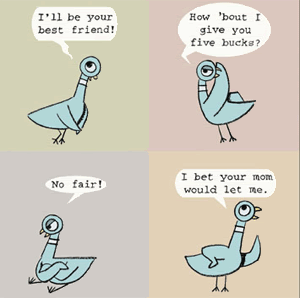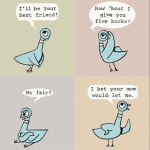
Show Don’t Tell: Examples from Children’s Books
 Some picture books are narrative all the way through with no dialogue, and some are only dialogue with no other narrative, as in Mo Willems’ wonderful “Don’t Let the Pigeon Drive the Bus” series. Most often, they are a blend of both.
Some picture books are narrative all the way through with no dialogue, and some are only dialogue with no other narrative, as in Mo Willems’ wonderful “Don’t Let the Pigeon Drive the Bus” series. Most often, they are a blend of both.
Generally speaking, dialogue should make up at least one-third of a picture book, and should convey as much information as the narrative text. Dialogue enables the writer to be both direct and economical – it’s far more effective and efficient for a character to say, “Go away!” than for the narrative say, “He told her to go away.”
The key to dialogue is the way in which it reveals or develops character. What does the way in which our characters speak say about who they are – their age? Level of education? Background? The time period the story is taking place in? For instance, what do you know about a character who says, “I’ll be your best friend!” versus “I’d be forever in your debt…”?
We also want to think about the words themselves conveying emotion, rather than needing to comment on or explain the emotion with adjectives and adverbs. This is often referred to as “show, don’t tell” – otherwise known as the writer’s mantra. “Show, don’t tell” means “reveal through the action of the story, rather than telling us or describing things to us.” Show us how naive, shy, judgmental, ornery, or practical so-and-so is… how much he loves his blankie, hates bugs, wants to drive the bus. Show us through action, behavior, and dialogue, rather than you, the narrator, telling us with descriptive text. Keep the focus on verbs rather than adjectives and adverbs, and action rather than description, to move your story forward.
Here again, Mo Willems’ books are worth studying. The pigeon’s state of mind, his emotional journey, progresses through each book with only dialogue and body language. The pigeon sits on the ground, with wings crossed and a frown on his face, saying, “No fair!” and we know he is a) a child, b) both angry and disappointed, and c) resigned to his lot. Mo Willems is a true master of “Show, don’t tell” – and even those of us who use narrative text can learn from his example.
